List of Authors
>>About this blog
Recent blog post
|
[Sam]
June 15, 2015 09:00
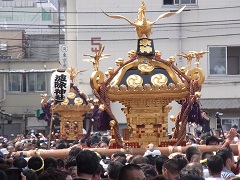 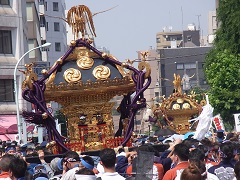
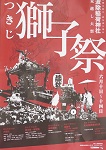 On June 10-14, Tsukiji Nami Inari Shrine has been holding the Tsukiji Lion Festival, a summer festival that has been around since the Edo period. On June 10-14, Tsukiji Nami Inari Shrine has been holding the Tsukiji Lion Festival, a summer festival that has been around since the Edo period.
The origin of the festival is said to date back about 350 years ago from the time when Tsukiji, which was once a sea, was reclaimed. When the reclamation work was extremely difficult, the shrine hall was built and enshrined in the sacred object of worship of Inari Oga, floating on the sea surface. People who were surprised at the new height of the virtue have given Inari Ogami the honor of `` Nami '', and have several giant heads of a dragon that obeys clouds, a tiger that obeys the wind, and a lion that jealizes all things with a single voice. It is said that the festival "Tsukiji Lion Festival" was carried around.
The Tsukiji Lion Festival has a main festival held every three years and a shadow festival held during that year, but this year is the year of the main festival.
Following the 10th Grand Festival, the 11th Cherry Blossom Festival celebration before the main festival, the 12th Kagura Festival and the Edo-ri Kagura dedication, the 13th is finally the main imperial procession Festival.
This is the last festival before the relocation of the Tsukiji Market, and the Mizu Shrine Dai portable shrine tour around Tsukiji together.
It is said that portable shrine, a different shrine, rarely travels together, and this is the first and last opportunity for the "Senukigu Shrine portable shrine Benzaiten Otoguro Lion" to travel with the "Sui Shrine Dai portable shrine".
Miyade (imperial procession, Miyamoto imperial procession-imperial procession, Tsukiji-cho, to the shrine.
Even in the lively area where turley, forklifts and small cars come and go, this day was cleaned refreshingly and greeted by a cruise.
In particular, the two portable shrine rubbing scenes are impressive, with the lively shouts of the fish riverbanks echoing.
In addition to the crowds of spectators, the maximum temperature in the Tokyo region on the day was 29.0 ° C.
The inside of the hall was filled with excitement.
The following day, on the 14th, we are planning to enter the Benzaiten Tokoku Lion Palace and join each town shrine.
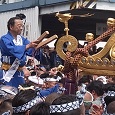 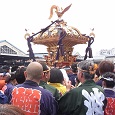 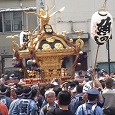 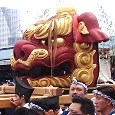
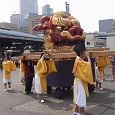 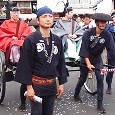 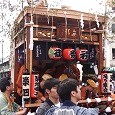 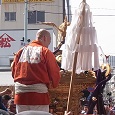
More Tsukiji Lion Festival imperial procession Festival 2015
[CAM]
June 14, 2015 14:00
"Ginza Makeup" is a work of 1951 (you can see it on You Tube). Among them, the streets of the Tsukiji River before being reclaimed and its neighborhood are beautifully captured.
The heroine Kinuyo Tanaka is a woman from Ginza, but it's not so gorgeous or young. The setting is to live alone with a boy about 6 years old and rent the second floor of Shimotaya, a teacher of Nagauta in Shintomi-cho.
Originally, both Ginza and Tsukiji were "islands" surrounded by rivers on all sides. Since Sanjumabori was reclaimed with rubble in the war around 1949, such rivers have been reclaimed one after another, and most of the Tsukiji River has disappeared. In the movie, I walked Harumi-dori St. from Tsukiji to Ginza and near Miharabashi, Kinuyo Tanaka told Yuji Hori, `` This Hen is Sansanbori, and before it was not reclaimed, bars on both sides at night etc. The lights of coffee shops moved to light and it was very beautiful. " Miharabashi also shows Tokyo Onsen, which was under construction at the time.
Since the defeat of Japan was in April 1952, it was "Occupied Japan" (Occupied Japan). However, there was no English street display in the movie, and the Hattori Clock Store Building should have been US military PX, but I can't see it. There are no foreign soldiers walking on the street. However, at the Ginza 4-chome intersection, Kinuyo Tanaka told Yuji Hori, "There were stalls on both sides until this time." After the Sanjuma moat landfill, you can see the rubble that has not yet been completely removed.
In addition, on the screen, you can see the scenery of Tsukiji Kawai at the time, such as the Tower of the Cross at St. Luke Hospital, Irifune Bridge, Akashi Bridge, and Tsukijibashi.
[Dimini ☆ Cricket]
June 14, 2015 14:00
The flowers of Nouzenkazura (Ryozen), which continued to bloom dark orange (or yellow) on the hot peak, were already blooming.
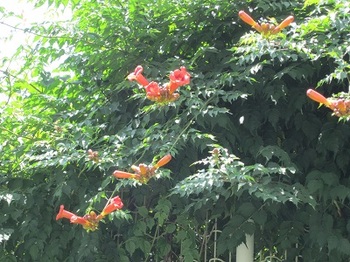
The location is along the fence on the Tsukiji side of Tsukiji River Ginza Park, built on the Metropolitan Expressway on both sides of Mannen Bridge (orange part).
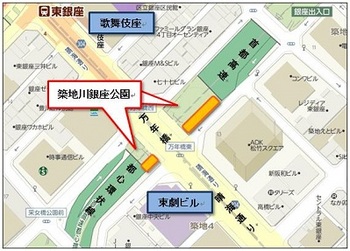
Nouzen Kazura is a vine plant native to China, but it has been popular with us Japanese since ancient times so that the name can be seen in the herb book "Honzo Wamiyo" of the Heian period (Heian period).
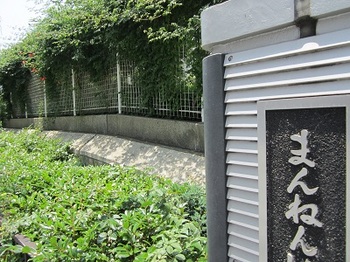
Because it is a plant that love s the sun, the rainy season s the sun, the rainy season  has not yet dawned, and I am worried that the buds will fall without blooming due to lack of sunshine, but somehow survive has not yet dawned, and I am worried that the buds will fall without blooming due to lack of sunshine, but somehow survive  the rainy season and under the scorching sun the rainy season and under the scorching sun , I want you to continue to bloom. , I want you to continue to bloom.
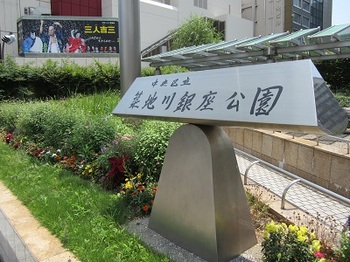
  
[Ashuan husband]
June 14, 2015 09:00
Recently, Ginza has an increasing number of customers from overseas, and it seems that there are more foreigners in Weekdays than Japanese. It must be good for customers to buy a lot of souvenirs when they say "explosive buying".
The other day, I noticed walking around Ginza, but when I walked from 1-chome to 8-chome, the state of the sidewalk changes from around 4-chome. "It's just like Paris." There is almost no trace of chewing gum on the sidewalk around Matsuya.
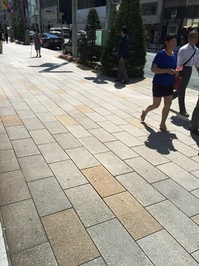
When you come around 6-chome, a lot of sightseeing buses are waiting for customers. On the sidewalk, there are times when foreign language speakers hang out and stay ahead. In addition, there are many traces of gum stuck on the sidewalk around it. It's just like Paris.
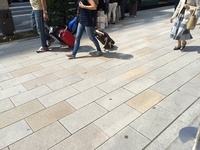 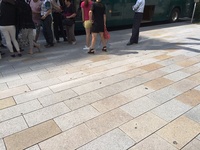
I like the city, and I like both Ginza and Paris, but I can't admire the dirt of the city of Paris. In Paris, both sidewalks and subways are dirty compared to Tokyo. I'm worried that if the traces of gum in Ginza increase as it is, it will not be far away from the sidewalks of Tokyo or the subway as much as Paris. It is said that money and garbage are stored in dirty places. I would like you to work on the beautification of the city of Ginza so that you do not fall into such a situation before the Tokyo Olympics.
1.
June 13, 2015 09:00
The day after the rainy season in the Kanto region was reported, it rained in Ritsuyoshi. The museum is perfect for such a day. I decided to go to Musee Yozo Hamaguchi, which I had been worried about for a long time. It's right next to Suitengu TCAT. According to the receptionist, it was a warehouse space for former Yamasa soy sauce. The printmaker Yozo Hamaguchi is the third son of Gihei Hamaguchi, the 10th president. The museum was opened in 1998 by Yamasa Soy Sauce as a place to exhibit his works after returning to Japan after his long overseas life in San Francisco. Speaking of Yozo Hamaguchi, the works of red cherries and watermelons on a black background immediately come to mind, but he was the one who pioneered the technique of coloring this monochrome mesotint called color mesotint. This is a two-person exhibition with the same mesotint writer Niwako Tannami. I feel a little tired when I see the works on the first floor and 60 underground. This museum has a cafe at the entrance and can be used only by the cafe. When I paid the admission fee, I received a discount ticket of 150 yen for the cafe, so I immediately went to the cafe. I was wondering whether to use "Marble Soy Sauce Ice Cream Set" 800 yen or "Cheese Cake Set" 900 yen, but I was informed that "I mixed vanilla ice cream with black honey soy sauce" . It is a very luxurious time to have a coffee while watching the rain falling over the glass.
"A museum on rainy days" is recommended.
Muse Yozo Hamaguchi / Yamasa Collection Nihonbashi 1-35-7 Oystersugacho Opening hours 11:00 to 17:00 (Open from 10:00 on weekends and holidays). Monday closed
Nearest station, near Exit 3 in Suitengu-mae, Ningyocho A2 Exit 8 minutes
Yozo Hamaguchi and Niwako Tannami Two-person Exhibition until June 30
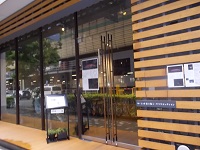 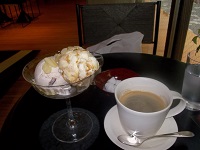
[I want to see]
June 12, 2015 14:00
I also go shopping in Yaesu and Yurakucho. shopping in Yaesu and Yurakucho.
Today, I run on Sotobori-dori St. in front of Tokyo Station (Yaesu Exit) toward Yurakucho.
It's past the hotel that has been closed now
There is a convenient bicycle rack that is convenient under the highway, so stop the bicycle there.
(This bicycle storage area is  free for up to 1 hour.) free for up to 1 hour.)
The destination is the corner building  (Ginza Fujiya Building) across the traffic light. (Ginza Fujiya Building) across the traffic light.
There is the "Lipton Tea School" (from 1994), which  I have been concerned about all the time. I have been concerned about all the time.
When I took a deep breath and pressed the elevator button and arrived on the second floor, there was a wonderful space waiting there~
Of course, it is a place for learning, but there is an open course. (We also sell black tea, etc.)
This month, there was a "Let's add hot tea" lesson (3,000 yen excluding tax) on June 4th. (I regret ) )
But it's okay
On June 18th (Thursday), the "Ginza Bee Project" was launched.
~ Honey lesson ~ There is a "Ginza Honey Course" (5,000 yen excluding tax). a "Ginza Honey Course" (5,000 yen excluding tax).
Focusing on honey born around Ginza and the Imperial Palace, yes, that honey collected in urban areas
Check the differences in taste depending on the type and time of the flower.
For tea time, add your favorite honey.
It seems that you can enjoy honey milk tea . .
Those who are interested in honey and those who love tea, please. 
For more information, please visit the following page.
http://www.liptonhouse.com/
|
Links
|
 On June 10-14, Tsukiji Nami Inari Shrine has been holding the Tsukiji Lion Festival, a summer festival that has been around since the Edo period.
On June 10-14, Tsukiji Nami Inari Shrine has been holding the Tsukiji Lion Festival, a summer festival that has been around since the Edo period.



















